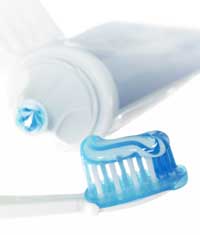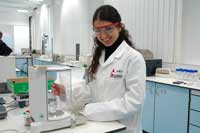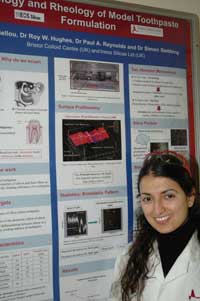You’re researching what? Toothpaste? Inspire article
Linda Sellou, a French PhD student at Bristol University, UK, tells Sai Pathmanathan, a science education journalist, what she thought of her school science and what she’s up to now…

iStockphoto.com
When did you first become interested in science? Was it sparked by a particular event? Linda remembers:
“It was when I went to ‘la cité de la science’ [city of science] in Paris for the first time. I was quite young (still at primary school) but I remember being fascinated by the reactions in which there was a change of colour and thinking that liquid nitrogen looked very cool! From then, my interest grew gradually until secondary school where I found out that food and cosmetics were related to chemistry!”
Most girls love their make-up, but how many would make the link between chemistry and cosmetics, and how many young girls are inspired to study science after school? Linda feels she is a very fortunate individual. School science not only allowed her to discover what science is all about, but also made it more accessible and showed her how science is applied in everyday life. She was even more excited when it was time for practical work. And without school science, Linda wouldn’t be where she is today, enjoying scientific research.
“Science is everywhere around you, I like being able to understand what is going on in my life!”
When most of us think of cosmetics, eye-shadow, mascara and bright red lipstick all spring to mind. No one thinks about toothpaste. Yet there are scientists researching the properties and components of toothpaste, and Linda is one of them. She is currently researching the abrasiveness of toothpaste: the roughness of different types of silica particles found in the paste. She studies the structure of these particles and how they scratch the teeth. For toothpaste manufacturers, it is vital to know as much information as possible about the components.
Toothpaste works by removing the protein layer (pellicle) formed on the surface of the teeth after exposure to saliva, which would otherwise cause tooth decay. To remove this pellicle, an abrasive toothpaste is needed, but the paste cannot be too abrasive, or the dentine (at the gum margin) will wear away.

Image courtesy of Tim Harrison
Linda began by making and characterising a toothpaste base composed of silica, sorbitol, polyethylene glycol, sodium dodecyl sulphate, sodium carboxymethyl cellulose and water. In commercially available toothpastes, flavour and fluoride are also added. She tests both the abrasiveness and the cleaning efficacy of the toothpaste base in vitro, using a brushing machine with a lateral motion. Using extracted teeth, it would have been possible to test the toothpaste on slices of dentine, but Linda found it more practical to use a Perspex (polymethylmethacrylate) model, which has similar physical properties to dentine. For the abrasiveness test, she brushes the Perspex plate for a certain time using the toothpaste base and calculates the abrasiveness index by quantifying the reflectance of the Perspex before and after brushing. To measure how effective the toothpaste is at cleaning teeth, Linda performs similar tests using previously stained hydroxyapatite (apatite crystals of calcium and phosphate, [Ca10(PO4)6(OH)2]), which is the main component of enamel. By comparing toothpaste bases containing different types of silica particles, Linda can find the ideal toothpaste components.“Basically, the issue is to provide maximum tooth cleaning and minimum tooth abrasion. I find it interesting simply because it directly touches everyone – twice a day!”
Linda always knew she wanted to study chemistry. After the Baccalaureat, she sat the competitive exams to enter university, the ‘Ecole Nationale Supérieure de Chimie de Lille’, to study physical chemistry. In her final year of study, she moved to the University of Bristol, UK, as an ERASMUS student. Her research project was on fragrances, based at the Bristol Colloid Centre. And when, at the end of the year, the centre offered Linda a PhD studentship with them to research toothpaste, she didn’t hesitate to accept.
Linda was quite lucky with the way everything fell into place. She realises that others may not be quite so fortunate, but she advises them not to give up: “Stick to what you want to do and never be discouraged by what people say.” Linda recommends to anyone wishing to follow a similar career path that they take time to decide which field to specialise in, and choose appropriate school and undergraduate science projects. Of course, talking to people in the field helps.
Linda believes that background, status or education should not prevent any student from following their dreams. “I come from the suburbs of Paris (‘banlieue’), which are traditionally where immigrants, in particular low-income families, have settled. The ‘banlieue’ are often characterised as sensitive areas, and were the site of well publicised riots in 2005. Because of the situation in which the children grow up, they are not always aware of the options they have in education or are discouraged before they even start. Sadly, some teachers also underestimate the abilities of pupils from these areas, and do not think we are capable of further education.
“At college, my mathematics and physics teachers told me I was not good enough to apply for ‘classes préparatoires’ or to become an ‘ingénieure’ in chemistry [‘classes préparatoires’ are preparatory courses for the competitive entrance examinations to one of the ‘grandes ecoles’, elite higher education institutions. An ‘ingénieur’ is a graduate of one of the grandes ecoles]. The only encouragement I got was from my French-language teacher! My parents, however, were very supportive although they do not know anything at all about science or even higher education. My mum is a housewife and my dad is a building painter who emigrated from Algeria 40 years ago, but they’ve always encouraged me even though they couldn’t understand what I was doing. To be honest, at first I was a bit confused by the conflicting messages, but then I decided not to listen to the teachers and carried on working even harder.”
Today, the situation in schools in the ‘banlieue’ is far from perfect but there have been improvements, such as more tutoring and counselling on a regular basis at secondary school. Linda believes that this is the key, especially if there is nobody at home who is able to help.
But science is not all hard work and exams. And you don’t need to be a Hollywood actress to win awards. Last October, Linda won one of only four poster prizes at the 12th IACIS International Conference on Surface and Colloid Science in Beijing. “Being only a second-year PhD student, I found it so gratifying and reassuring to have my work appreciated and recognised. It gives me a real boost to work even harder and make further discoveries.”

Image courtesy of Tim Harrison
But Linda admits that the image of science could be improved. “Sometimes people think that science is hard work and boring. It also seems to have this nerdy image. I am not saying it is not hard work; of course we work hard. But science, particularly chemistry, can be very enjoyable and is accessible to everyone. It all depends on how it is approached. Teachers, of course, play a major role in this. For example, my three little sisters think science is too hard, just numbers, equations and formulae, because that is the way they are taught at school. But when I tell them that chemistry is all around us, from their clothes, toiletries and medicines to their favourite foods, they are surprised. They ask me why they are not told this at school. Although applications of science are obvious to the teachers, they are not always so clear to the students.
“When I introduce myself to people, I say I am doing a PhD in chemistry. People rarely ask what I am researching because they think they won’t understand. But when I tell them my research is all about toothpaste, they smile or even laugh because it is simple, applied and they know what it is!”
Many scientists are great communicators, and Linda is no exception. While studying for her degree in France, she worked with the UIC, a French chemical industry association. Linda would visit schools with someone from the chemical industry to give talks on chemistry in general and its applications. Now in Bristol, Linda is an active science and engineering ambassador in a scheme supported by SETNET.
This scheme links schools and school students with organisations involved in science, technology, engineering and mathematics (STEM), providing young people with relevant and exciting activities and schemes. The ambassadors are drawn from diverse STEM backgrounds all over the UK, including employers, lab technicians, academics and postgraduate students. They share their enthusiasm and passion for their subjects, supporting school activities and hoping to inspire children from primary and secondary schools. The benefits of the scheme are diverse, providing extra support for teachers, allowing them to develop more varied teaching and learning styles, and to update their knowledge of contemporary science and technology, as well as the research process. To the students, the ambassadors bring a different approach and perspective, often more accessible and interesting for pupils, but also challenging.
“I enjoy working as a science and engineering ambassador very much. I am learning and developing communication skills but above all I feel good passing on my knowledge, helping students discover new things, sharing my interest with them and watching them enjoy the whole experience. Pupils can relate science to their everyday life and they are motivated and enthusiastic to learn more and hopefully I’ve inspired them to do a career in science.”
So what’s next for Linda? She’d like to discover more and publish her work. But more importantly, she’d like to travel, something that is generally not difficult in academia. “Perhaps Australia. I am very keen on discovering other cultures and I am also interested in learning about other fields, like biochemistry. In the meantime, I’ll carry on working with schools and maybe set up some links between British and French schools and scientists!”





